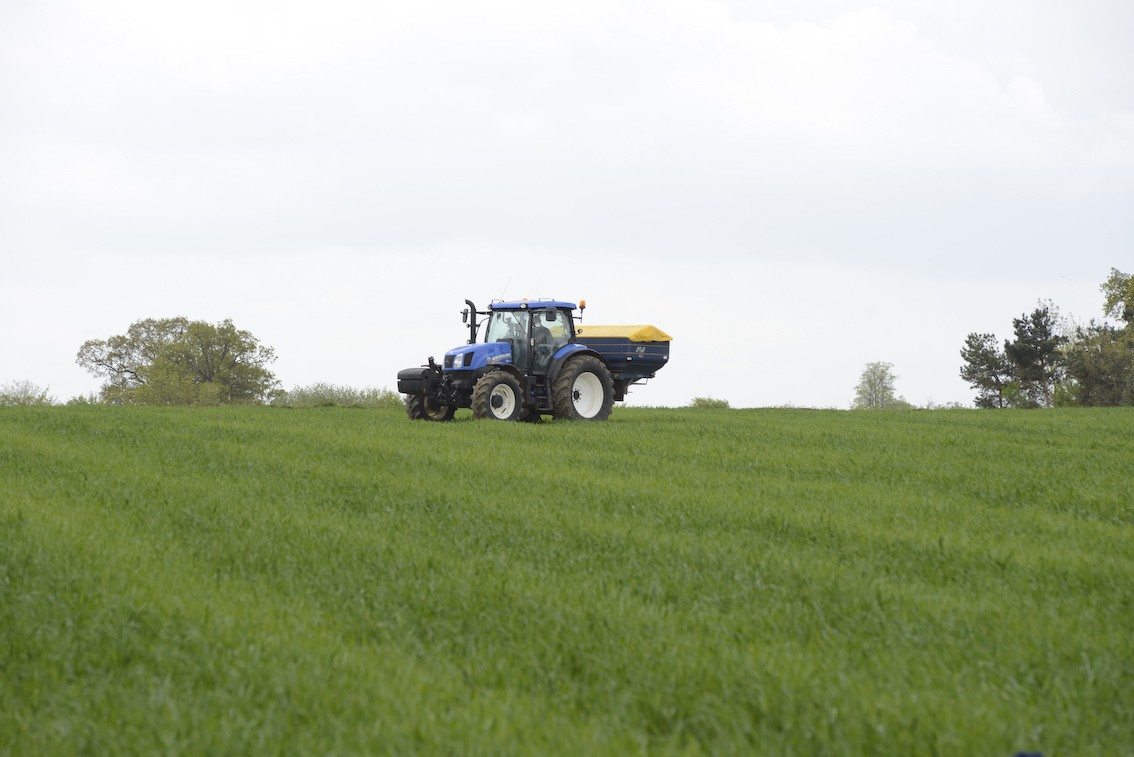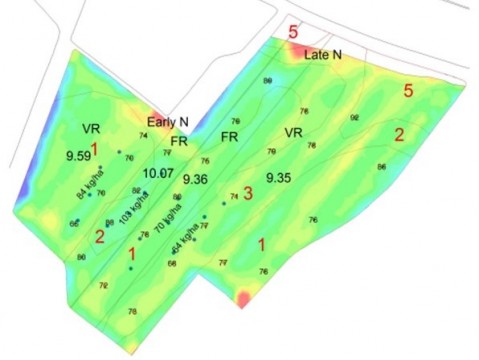Enhancing farm efficiency with variable rate nitrogen – What do the latest trials results tell us?
The start of a new year is often when most of us traditionally think back to what has happened over the past 12 months before looking ahead at those to come.
Before Christmas, we published this news release announcing some exciting digital investments that have upgraded our variable rate nitrogen service for 2022. One of the most significant developments is the adoption of radar technology, meaning users can now access cloud-free imagery.
We're really excited to be able to link growers to this upgraded service and the benefits it can offer but, as mentioned, we also have some useful learnings from 2021 to bring with us too. With that in mind, now seems the perfect time to bring you updates from last year's variable rate nitrogen (VRN) trials in winter wheat.
Nitrogen Use Efficiency (NUE)
With so much focus on farm sustainability, fertiliser usage and the obvious market challenges this season, perhaps one of the most pertinent results for many growers will be around Nitrogen Use Efficiency (NUE). NUE is a measure of how efficiently nitrogen is used by the crop to produce a product (i.e. grain). It is worked out using the below formula:
VRN targets nitrogen applications where they are required and can provide the greatest benefit when based on satellite and now radar imagery. You can see from the table below that all the trials show an increase in NUE of between 1-6% with variable rate applications. Put simply, based on the average benefit of 4%, by using VRN you could achieve the same yield by applying 4% less nitrogen. Therefore, if you are applying a total of 220KgN/ha over the season it could be equivalent to saving yourself £16/ha (or 8.8KgN/ha) with no yield penalty.
| Trial field | NUE % - VRN | NUE % - Flat rate | Benefit of VRN | Value of N saved per ha (based on AN at £630/t) |
| A | 89 | 83 | +6% | £24.16 |
| B | 88 | 83 | +5% | £20.13 |
| C | 92 | 90 | +2% | £8.05 |
| D | 95 | 94 | +1% | £4.03 |
| Average | 91 | 87 | +4% | £16.10 |
This potential saving is obviously a sizeable one, especially when you scale it up across your entire winter wheat area for the season. However, there is also another way to look at the benefit of increasing your NUE and that is to assess the potential yield benefit of an extra 4% of your applied nitrogen going into the crop. This is slightly more difficult to quantify but one way we can estimate it is by converting the 8.8KgN/ha into equivalent yield at a standard protein level. The AHDB wheat growth guide states that only 68% of the N taken up goes into the grain, with the remaining 32% in the biomass. This means that in our example, 6KgN will go to the grain. By using the calculation outlined below, we can estimate that the 4% increase in NUE we observed is potentially equivalent to a 0.37t/ha yield increase. At a conservative grain price this season of £200/t, this could equate to an additional £74/ha. I should add that this improvement is assuming that you are in a yield responsive situation, where adding additional N will increase your yield.
6Kg/N ÷ 1.9% (Typical Grain N) = 315Kgs
315 ÷ 85% (this accounts for the water within the grain) = 370Kgs
I think it's more than fair to say these benefits would be significant for many people, especially if you're keeping a close eye on your nitrogen applications this season.
Furthermore, by increasing your NUE you reduce the risk of excess nitrogen being left in the soil which can be susceptible to leaching. This was demonstrated in another of our trials where we tested the residual nitrogen left in the soil after harvest; the areas of the field where VRN applications were made had 12.5kg/ha less residual nitrogen than the flat rate areas.
Yield
As you would likely expect following the improvements in NUE and its potential yield impacts that I've already discussed, we recorded increased yields across all fields. On average we saw an increase of 0.22 tonnes/ha. Although this may seem modest to some of you at £200 per tonne, it equates to a financial return of £41.50/ha. Even when the cost of the service (£8/ha) is accounted for, it still returns a more than healthy benefit of £33.50/ha.
| Trial field | Yield (t/ha) VRN | Yield (t/ha) - Flat rate | Cost benefit at £200/t |
| A | 10.54 | 10.36 | £36/ha |
| B | 9.68 | 9.6 | £16/ha |
| C | 9.75 | 9.45 | £60/ha |
| D | 11.19 | 10.89 | £60/ha |
| Average | + 0.22 | | £44/a |
Plant growth regulators (PGRs)
As we continue to see increasing interest in using imagery to variably apply plant growth regulators (PGRs), in 2021 we built upon our previous trials data. We conducted trials in both spring barley and winter wheat, seeing positive results in both relating to yield increases of 0.14t/ha and 0.33t/ha respectively. Variably applying PGRs was also shown to reduce the lodging risk of a crop and enhance the efficacy of crop protection products by helping to produce a more even canopy.
| Crop | Yield (t/ha) - VR PGR | Yield (t/ha) - Flat rate PGR | Yield benefit (t/ha) | Cost benefit |
| Winter wheat | 10.97 | 10.64 | 0.33 | £66/ha (based on £200/t) |
| Spring barley | 6.36 | 6.21 | 0.14 | £29.68/ha (based on £212/t) |
Combined benefits
When we look at the results of these trials together, they present a very compelling case for VRN being a part of every farm's crop management strategy, particularly given the growing focus on efficiency and profitability. If we look purely at the winter wheat, the trials show that the NUE improvements would at the least on average pay for the cost of the service twice over and could if converted to additional yield offer a very significant return. The combined financial return of the yield uplift from variably applying nitrogen and PGRs alone, which comes in at £107.50/ha, provides a very healthy return on an £8 investment - as well as offering wider sustainability and efficiency benefits.
Summary
I hope this brief overview of our 2021 variable rate nitrogen trials has been a useful insight into the work we conduct to ensure our services are delivering real results for growers. While the findings themselves all show clear advantages in terms of crop production, they also present tangible benefits for farm sustainability. As an example, by increasing your NUE you can reduce your carbon footprint and simultaneously lessen your impact on local environments by reducing the risk of excess nitrogen leaching into watercourses.
If we think about and the direction of travel within the industry and expectations for the coming season, I think the key point to take from these results is that input efficiency is crucial but it's equally important to judge a practice or approach by the benefits it delivers to multiple areas, including sustainability.
To learn more about our VRN service, visit the SOYL website or email This email address is being protected from spambots. You need JavaScript enabled to view it.
As a subscriber, you’ll receive email alerts each time a new blog is published so you can always stay updated with the latest advice and insights from our experts





Comments